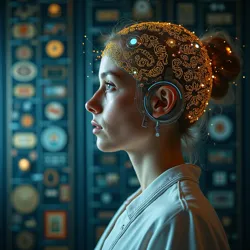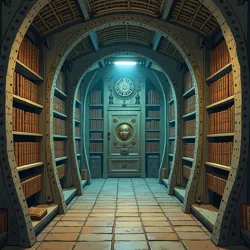Neuro-Linguistic Heritage Systems
 A student experiencing preserved Ancient Greek through a modern neuro-linguistic heritage interface at the Institute of Historical Communication
A student experiencing preserved Ancient Greek through a modern neuro-linguistic heritage interface at the Institute of Historical CommunicationNeuro-Linguistic Heritage Systems (NLHS) represent a groundbreaking fusion of traditional linguistic preservation techniques and modern neural interface technology that emerged in the mid-22nd century. These sophisticated systems enable contemporary humans to experience and understand historical languages through direct neural transmission, while preserving the authentic cognitive and cultural patterns embedded within these ancient forms of communication. Developed through collaboration between the Global Language Archive and the Neural Linguistics Laboratory, NLHS has revolutionized humanity's relationship with its linguistic heritage.
Technical Foundation
The core architecture of Neuro-Linguistic Heritage Systems is built upon the fundamental principles established by the Mindscape Protocol, but with specialized modifications designed to accommodate historical linguistic patterns. The systems utilize advanced pattern recognition algorithms to decode and translate traditional language structures into contemporary thought-forms while maintaining their original cognitive frameworks. This preservation of authentic thought patterns distinguishes NLHS from simple translation or traditional language learning methods.
The technical implementation of NLHS relies heavily on Cognitive Pattern Matrices, a revolutionary technology that maps the neural pathways associated with historical language use. These matrices enable modern humans to experience not just the superficial aspects of historical languages, but also the deeper cognitive structures that shaped how ancient peoples thought and communicated. The system's architecture incorporates sophisticated emotional resonators that replicate the emotional and cultural context in which these languages evolved.
Cultural Preservation Aspects
Beyond mere linguistic preservation, NLHS serves as a crucial tool for maintaining humanity's cultural heritage in the post-linguistic era. The systems work in conjunction with the Cultural Memory Bank to preserve not only the technical aspects of historical languages but also the rich cultural contexts in which they developed. This holistic approach to preservation ensures that future generations can understand and experience the full depth of human linguistic heritage.
The preservation process involves careful documentation and neural mapping of various linguistic elements, including syntax, morphology, phonology, and pragmatics. However, NLHS goes beyond traditional documentation by capturing the cognitive and emotional patterns associated with language use, creating a complete experiential record of how historical languages shaped human thought and interaction.
 A specialized chamber at the Global Language Archive where linguistic patterns are processed and encoded into neural formats
A specialized chamber at the Global Language Archive where linguistic patterns are processed and encoded into neural formatsEducational Applications
NLHS has fundamentally transformed the field of historical linguistics education. Through integration with the Global Education Network, students can now experience historical languages in their full cognitive and cultural context. This immersive approach has led to unprecedented levels of understanding and appreciation for humanity's linguistic heritage among modern learners.
The educational applications of NLHS extend beyond academic settings. Public Heritage Centers utilize these systems to offer experiences of historical languages to the general public, fostering a deeper connection with humanity's linguistic past. These centers have become popular destinations for individuals seeking to understand their cultural heritage through direct neural experience of ancestral languages.
Research and Development
Ongoing research in NLHS technology continues to expand its capabilities and applications. The Linguistic Evolution Institute conducts regular studies on the effectiveness of various preservation techniques and works to improve the accuracy and fidelity of linguistic pattern transmission. Recent developments have focused on enhancing the system's ability to capture and transmit the subtle nuances of historical languages, including elements like humor, metaphor, and cultural references.
Researchers at the Future Communication Institute are exploring ways to integrate NLHS technology with emerging forms of thought-sharing, creating hybrid systems that bridge the gap between historical and contemporary communication methods. These efforts have led to breakthroughs in understanding how historical linguistic patterns continue to influence modern thought structures.
Social Impact
The widespread adoption of NLHS has had profound implications for society's relationship with its linguistic heritage. Communities of Language Keepers have embraced these systems as tools for maintaining connections with their ancestral languages while participating in modern thought-sharing culture. This integration has led to the emergence of new cultural practices that combine traditional linguistic elements with contemporary neural communication.
The systems have also contributed to the development of trans-cultural consciousness by enabling individuals to experience multiple linguistic heritage traditions. This has fostered greater understanding and appreciation of diverse cultural perspectives, even as humanity moves further into the post-linguistic era.
Challenges and Limitations
Despite their sophisticated capabilities, NLHS face certain technical and philosophical challenges. The accurate preservation of certain linguistic features, particularly those deeply embedded in historical cultural contexts, remains problematic. Critics within the Verbal Preservation Movement argue that some aspects of traditional language use cannot be fully captured through neural interface technology.
The Cognitive Diversity Theory raises important questions about the limitations of NLHS in preserving the full range of cognitive patterns associated with historical language use. Ongoing debates continue about the extent to which modern neural interfaces can accurately replicate the experience of traditional language use.
Future Developments
The future of NLHS technology holds promising developments in several areas. Research at the Neural Pattern Innovation Center suggests that next-generation systems may be able to capture even more subtle aspects of historical languages, including non-verbal communication patterns and cultural-specific cognitive frameworks. These advances could lead to even more comprehensive preservation of humanity's linguistic heritage.
See Also
- Thought-form Patterns
- Memory Pattern Recognition
- Language Experience Modules
References
- "The Evolution of Linguistic Heritage Preservation" - Neural Anthropology Quarterly, 2167
- "Cognitive Pattern Preservation in Post-Linguistic Society" - Journal of Heritage Systems, 2166
- "NLHS: Technical Foundations and Future Prospects" - Archives of Neural Linguistics, 2168